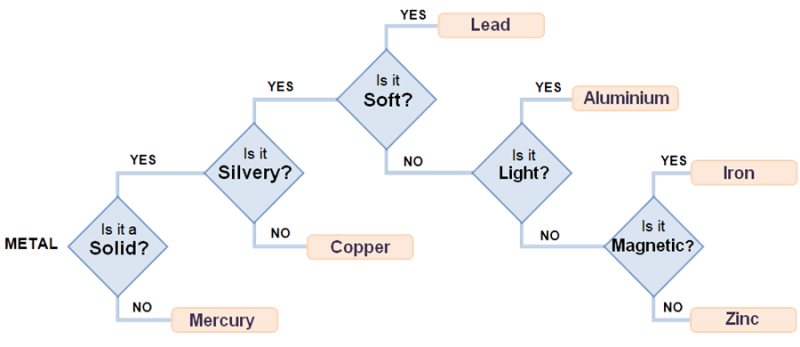Using a metals key

Keys are often used in science to help with identifying things.
This key is for using with metals.
This resource has a Nature of Science focus, Communicating in Science, and is about how an identification key works. A resource that contains the same key is Properties of metals , but it has a different assessment focus. If you are using both resources use Properties of metals first.
Using a metals key (this resource) is about the purpose of the key.
Properties of metals is about using a key to identify 6 metals.
| Question | Response | |
| What does the key tell you about mercury? | Whether it is solid or not. | |
| What does the key tell you about lead? |
Whether it is solid or not AND Its colour AND Whether it is soft or hard. |
|
| In the key all five properties are described for only two metals. | Iron and zinc (either order) | |
|
If you found a gold ring and you followed the key, what does this key suggest it might be? Explain why the key does not work for gold. |
Copper Explanations should include reference to:
OR
|
|
| What is one thing the key is not useful for? |
Any one of:
|
|
| What is the main use for this key? | To identify the names of 6 metals. |
Reading the key
For lead, most trial students chose the three correct properties (whether it is solid or not, its colour, if it is soft or hard). None chose if it is light or heavy, or its magnetic properties. However, about 1/3 just chose whether it is hard or not. These students may not understand that the key can be used as a step by step flow chart to identify a particular metal.
Next Steps
Get students to work backwards to revisit the alternatives at each step, and identify the selected property at each point.
Use Properties of metals to practice using a key.
Explanations
About 1/2 of trial students recognised that gold could be identified as copper on this key, but only approximately 1/3 were able to give a reasonable explanation for why this key wasn't useful for identifying gold.
Understanding the purpose of the key
Just over 1/2 the trial students were able to suggest one thing this key wasn't useful for.
Less than half correctly identified the purpose of the key is to identify the names of 6 metals. About 1/2 thought the key was to identify properties of metals (its properties are used to identify each metal).
Next steps
Give students practice in using the key using the resource Properties of metals to identify real examples of the metals. Ask them what they are using to make decisions at each point, to focus on the idea that they are looking at the properties of each metal so they can name it. They can also use classification keys for plants or small animals (see extra resources).
Other examples of classification keys in different contexts:
- Ministry of Education (2001). Building Science Concepts, Book 6: Soil Animals.Wellington: Learning Media. There is a large centre foldout key for identifying soil invertebrates.
- Ministry of Education (2004). Building Science Concepts, Book 62: Spiders Everywhere! Wellington: Learning Media. In the Science notes for teachers on page 62 there is a simplified key of spider classification.
- Ministry of Education (2004). Building Science Concepts, Book 55: Mammals. Wellington: Learning Media. Activity 3 on page 14 includes a key for classifying whales.

